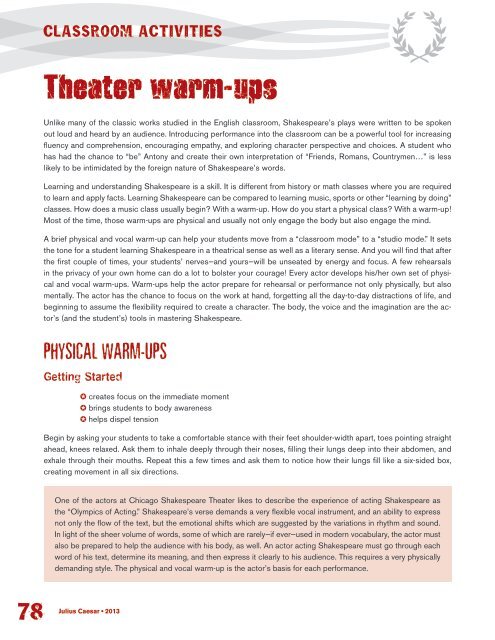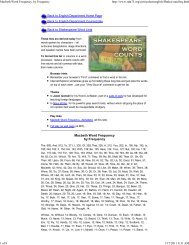Julius Caesar • 2013 - Chicago Shakespeare Theater
Julius Caesar • 2013 - Chicago Shakespeare Theater
Julius Caesar • 2013 - Chicago Shakespeare Theater
Create successful ePaper yourself
Turn your PDF publications into a flip-book with our unique Google optimized e-Paper software.
78<br />
CLASSROOM ACTIVITIES<br />
<strong>Theater</strong> warm-ups<br />
Unlike many of the classic works studied in the English classroom, <strong>Shakespeare</strong>’s plays were written to be spoken<br />
out loud and heard by an audience. Introducing performance into the classroom can be a powerful tool for increasing<br />
fluency and comprehension, encouraging empathy, and exploring character perspective and choices. A student who<br />
has had the chance to “be” Antony and create their own interpretation of “Friends, Romans, Countrymen…” is less<br />
likely to be intimidated by the foreign nature of <strong>Shakespeare</strong>’s words.<br />
Learning and understanding <strong>Shakespeare</strong> is a skill. It is different from history or math classes where you are required<br />
to learn and apply facts. Learning <strong>Shakespeare</strong> can be compared to learning music, sports or other “learning by doing”<br />
classes. How does a music class usually begin? With a warm-up. How do you start a physical class? With a warm-up!<br />
Most of the time, those warm-ups are physical and usually not only engage the body but also engage the mind.<br />
A brief physical and vocal warm-up can help your students move from a “classroom mode” to a “studio mode.” It sets<br />
the tone for a student learning <strong>Shakespeare</strong> in a theatrical sense as well as a literary sense. And you will find that after<br />
the first couple of times, your students’ nerves—and yours—will be unseated by energy and focus. A few rehearsals<br />
in the privacy of your own home can do a lot to bolster your courage! Every actor develops his/her own set of physical<br />
and vocal warm-ups. Warm-ups help the actor prepare for rehearsal or performance not only physically, but also<br />
mentally. The actor has the chance to focus on the work at hand, forgetting all the day-to-day distractions of life, and<br />
beginning to assume the flexibility required to create a character. The body, the voice and the imagination are the actor’s<br />
(and the student’s) tools in mastering <strong>Shakespeare</strong>.<br />
PHYSICAL WARM-UPS<br />
Getting Started<br />
✪ creates focus on the immediate moment<br />
✪ brings students to body awareness<br />
✪ helps dispel tension<br />
Begin by asking your students to take a comfortable stance with their feet shoulder-width apart, toes pointing straight<br />
ahead, knees relaxed. Ask them to inhale deeply through their noses, filling their lungs deep into their abdomen, and<br />
exhale through their mouths. Repeat this a few times and ask them to notice how their lungs fill like a six-sided box,<br />
creating movement in all six directions.<br />
One of the actors at <strong>Chicago</strong> <strong>Shakespeare</strong> <strong>Theater</strong> likes to describe the experience of acting <strong>Shakespeare</strong> as<br />
the “Olympics of Acting.” <strong>Shakespeare</strong>’s verse demands a very flexible vocal instrument, and an ability to express<br />
not only the flow of the text, but the emotional shifts which are suggested by the variations in rhythm and sound.<br />
In light of the sheer volume of words, some of which are rarely—if ever—used in modern vocabulary, the actor must<br />
also be prepared to help the audience with his body, as well. An actor acting <strong>Shakespeare</strong> must go through each<br />
word of his text, determine its meaning, and then express it clearly to his audience. This requires a very physically<br />
demanding style. The physical and vocal warm-up is the actor’s basis for each performance.<br />
<strong>Julius</strong> <strong>Caesar</strong> <strong>•</strong> <strong>2013</strong>




